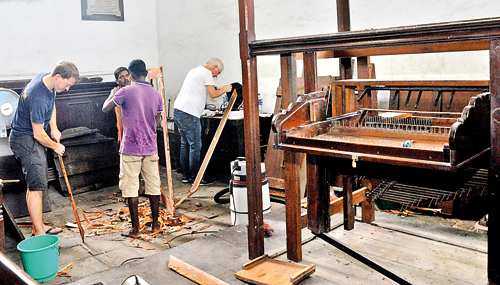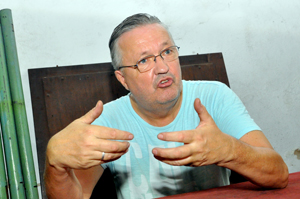Pipe by pipe, key by key, a silent organ comes to life

Hans Elbertse and son Jos (left) hard at work. Pix by Priyantha Wickramaarachchi
It would have been a very special day at the Wolvendhaal Church in Colombo when, over a century ago, the faithful gathered for prayers and heard for the first time the notes emanating from the newly installed pipe organ. Placed on the organ loft, the instrument with its 336 pipes and six different stops brought to life sounds ranging from the flute to trumpet and no doubt captured the imagination of those present.
But that was over a century ago and over the years the pipe organ lost its glory and has stood silent for many years. Now a team of three Dutchmen are working meticulously to restore it to its former glory and bring back the old familiar sounds to the country’s oldest Protestant church, the Wolvendhaal Church in Colombo.
The pipe organ repair and restoration work are part of the shared cultural heritage programme initiated by the Government of the Netherlands which assists in the preservation and maintenance of shared heritage sites in its former colonies. The team in Colombo will work in two phases, the first currently underway. They will return to the Netherlands later this month and return early next year to continue with the work.
Rudi van Straten, a senior specialist from the Cultural Heritage Agency of the Netherlands said they have been working on two projects, one in Colombo and in Galle, since early October. “The pipe organ at the Dutch Reformed Church in Galle more than 200 years old, the oldest in the country needs a lot of work before it can be restored to working condition. The one at Wolvendhaal is close to 140 years and we are confident of having it in working condition when we return to Sri Lanka early next year,” he said.
Even though the church was built by the Dutch around 1757, the pipe organ was installed during British rule, around 1880. It had been built by the world-famous organ builders Hill & Son from London.
Van Straten says it is likely they took the wood from Sri Lanka, built it in London and shipped it back here. “They have used jak wood to build the organ frame as it’s a local wood resistant to termites. The builders would have realized that the kinds of wood found in Europe would not last in the hot and humid conditions here,” he said. The pipe organ at the Galle Church, he said, has been built with the wrong kind of wood which is one reason it has deteriorated over the years and many of the pipes too have gone missing. In Wolvendhaal, all but three of the pipes are intact.
The keyboard will need extensive work as many of the keys are missing, likely stolen as they were made of ivory and were valuable, Van Straten said. The bellow which pushes air to power the instrument is in somewhat good condition and is getting a facelift from the restorers.

Rudi van Straten
The first phase of the project involves dismantling the instrument and cleaning its parts, which will then be stored in boxes till the team returns next year.
For the project, the Dutch Government has chosen the most renowned organ makers in the country, who were decorated by the Royal household of the Netherlands having celebrated their 100th anniversary in the trade.
Hans Elbertse and son Jos, third and fourth generation organ builders in the company founded by Johannes Josephus Elbertse born in 1883, are the duo who are meticulously working to get the pipe organ back to working condition.
“It is very exciting being here and seeing the Dutch heritage and being part of the efforts to preserve it,” Hans said.
Hans developed a love for organ making after seeing his father and grandfather in the workshop in the town of Soest in the centre of the Netherlands. The workshop has been at the same location since 1926.
“I went to high school and then I wanted to work in my father’s factory. He asked me to first go to carpentry school which I did and then I began work as an organ maker,” he said.
Jos is the newest addition to the family business and has joined his father on the project work in Sri Lanka.” We build new organs and also do restoration work in our country. This is our first time in Sri Lanka and it is fascinating to see the Dutch legacy that is retained here,” Jos said.
Their workshop in the Netherlands is a place where young people interested in carpentry can apprentice and learn on the job as part of their college education.
One part of the shared heritage project is to train locals to do the restoration work. Two Sri Lankans have been recruited for the project and are immersed in the work at Wolvendhaal.
Van Straten is hopeful that come next year, the pipe organ at Wolvendhaal will once again fill the church with the familiar sounds. “The pipe organ is a very versatile instrument. You can make a combination of sounds and even improvise popular music with it. We hope we can have a concert here with the pipe organ providing the music next year,” he said.


